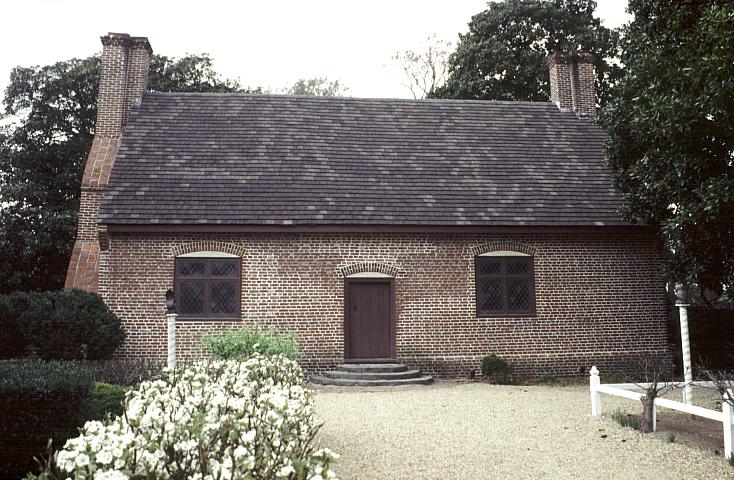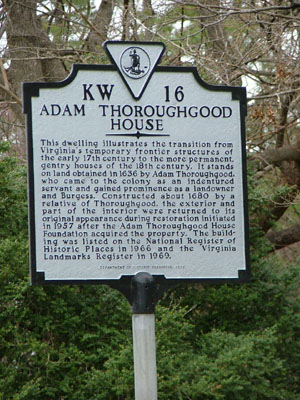Posted on August 15, 2017
Adam Thoroughgood House
Virginia Beach, VA

Image Source: Bluffton.edu
Last year, we ranked the Top 25 Most Haunted Places in Virginia, and included Virginia Beach’s Ferry Plantation House on our list. The mansion is said to be haunted by at least eleven spirits and was also the site of the infamous dunking of Grace Sherwood (aka The Witch of Pungo.) But Ferry Plantation isn’t the only scary place Virginia Beach has to offer. A few miles north lies the Adam Thoroughgood House, a simple brick cottage that’s small in size but big in paranormal activity.
Adam Thoroughgood was born in King’s Lynn, England in July 1604. He was raised in the same county as the famous explorer, Henry Spelman. In 1609, a fourteen year old Spelman was sent to Jamestown as a boy laborer. Jamestown was still a relatively new colony at the time; its hundred some occupants had yet to figure out how to support themselves. Thus, leader John Smith decided to seek help from a nearby Indian village, known as Powhatan. In exchange for food and supplies, Smith offered its chief “grindstone, some guns and swords, a cock and hen, copper and beads, and men to build Powhatan an English-style house.”1 Henry Spelman, who was with Smith during negotiations, was ordered to stay behind. His job was to learn the Algonquian language, then serve as a messenger between the colonists and the Native Americans.
For about a year and a half, Spelman lived with the Indians. He documented his experiences in Relation of Virginia. Though the manuscript was never published, a collector “had a small edition printed privately in London”2 in 1872. It offers a rare, firsthand look at the culture and lifestyle of the Algonquian Indians.
Henry Spelman died on March 23, 1623, during the War of Opchanacanough. He was bartering for corn from the Patawomeck tribe when things went horribly wrong. But the stories of his adventures appealed to a teenage Adam Thoroughgood. Thus, in 1621, he too decided to sail for Virginia, and to pay for his voyage through indentured servitude.
After completing his period of indenture, Thoroughgood secured a large landholding and began making a name for himself in Virginia. He was elected to the House of Burgesses in 1629, for example, and also served on the Governor’s Council. He was also very good at convincing others to move to the states. Thanks to his “ambitious plan of sponsoring immigrants”3 to the colony, one hundred and five English citizens relocated to Virginia from 1628 to 1635.
In 1636, Thoroughgood acquired a grand plantation – which covered approximately five thousand, three hundred and fifty acres of land – near the Lynnhaven River. He and his wife, Sarah Offley, moved there immediately. Early historians believed that he began building the Adam Thoroughgood House on it that same year. However, a later dendrochronology report concluded differently. Based on pine samples, “the housecould not have been constructed any time before 1704, and might well be one or more decades afterwards.”4 Today, most researchers agree that the house was built in 1719, nearly eight decades after Thoroughgood’s death.
Adam Thoroughgood passed away in 1640 and was buried at the First Church at Church Point. His widowed wife promptly remarried. Her new husband, John Gookin, was a burgess for Upper Norfolk, as well as a presiding magistrate for the lower part of the county.
Construction of the Adam Thoroughgood House was thus probably started by Adam Thoroughgood’s great grandson, Argall. Argall passed away before the house was completed, though, so many of its most exquisite elements are attributed to his wife and son. These include “its extensive wainscoting and paneling, as well as its dramatic turned staircase.”5
The Adam Thoroughgood House remained in the Thoroughgood family until the 1860s, after which it changed many hands. Today, it is one of the oldest, surviving homes from early colonial times. It is a central-passage house, also known as a Tidewater-type cottage. Its hall and parlor are divided by a central passageway, and it has a weather-boarded, timber frame. It also has an underground, secret passageway, which leads to the James River.
The house was nominated twice to be included on the National Register of Historic Places. According to the second nomination, made in 1972, the Adam Thoroughgood House stands at one-and-a-half stories tall and has “three walls laid in English bond and one in Flemish.”6 The report also lists several hallmark alterations made during the house’s lifespan. In 1745, the its walls were given additional panels, for instance, and its leaded glass panes were replaced with Georgian windows. Classic Georgian style architecture rose to prominence during the early 1700s, and was favored by middle and upper class citizens.
The Adam Thoroughgood House was opened to the public on April 30, 1957, as a museum. To prepare for the grand opening, the Adam Thoroughgood House Foundation asked the Garden Club of Virginia to restore the property’s landscape to its 17th century conditions. Two ornamental gardens, arranged in a geometric pattern, were also added. They flank the central entrance walkway and are planted with periwinkles (a beautiful, five-petaled, purple flower) and yaupon hollies. If you visit the building, you will be exposed to an eclectic mix of architectural styles. Some elements – such as its pyramidal chimney and dark brown trims – are of English Tudor origins, while others – including the bricks of its steep gabled roof – mirror those of eleventh-century Normandy buildings.
But what you will also experience at the Adam Thoroughgood House is lots of paranormal activity. “Over the years, tourists and museum interpreters have told [tour guide Starr Donlon] stories of ghost sightings and other strange, inexplicable events in the home and on the property.”7 Donlon herself has sensed unsettled souls, watching her from the building. Others have felt cold drafts while inside, despite the house’s lack of air conditioning.
At the Adam Thoroughgood House, objects – particularly candlesticks – also like to move on their own. “Once, in front of thirty tourists, four glass domes protecting Christmas candles suddenly levitated and crashed to the floor.”8 On another occasion, something supernatural shifted several heavy pieces of furniture.
One day, a psychic was brought in to give the house a reading. She sensed a lot of unhappiness and pain. Perhaps those who died violent deaths in the house were trying to communicate with her. One former resident, for instance, “shot himself in the headhalfway up the stairwell sometime in the 1700s.”9
In 2006, an archaeological survey of the property revealed that prior to the Thoroughoods’ arrival, the land was occupied by Native Americans. Did some tribe leave a portal to the afterlife open? This would certainly explain the estate’s abundance of ghosts. The ghost of a red-haired woman, dressed in traditional colonial garb, has been spotted multiple times roaming around the property. Inside the house, people have encountered the spirit of Sara Offley, carrying a candle. A male entity, dressed in a brown suit and believed to be Adam Thoroughgood himself, has also been seen wandering the halls.

Image Source: CarolsHouse.com
Works Cited
- Huber, Margaret Williamson. “Powhatan (d. 1618.)” Encyclopedia Virginia. Virginia Foundation for the Humanities. 30 Nov. 2015. Web. 11 April 2016. Para. 19.
- “Background – AJ-136 Document.” American Journeys. Wisconsin Historical Society, 2016. Web. 11 April 2016. Para. 5.
- Bellamy, Joe David. The Bellamys of Early Virginia. Lincoln: iUniverse, 2005. Page 31.
- “Adam Thoroughgood House.” National Register of Historic Places, Registration Form. United States Department of the Interior National Park Service. Rev. August 2002. Page 8.
- “Thoroughgood House.” History Museums. City of Virginia Beach, 2016. Web. 11 April 2016.
- “Adam Thoroughgood House.” National Register of Historic Places, Registration Form. United States Department of the Interior National Park Service. Rev. August 2002. Page 5.
- Frankenberry, Rita. “Ghost stories from the Adam Thoroughgood House.” The Virginian-Pilot.23 Oct. 2011. Web. 11 April 2015. Para. 3.
- Taylor, L.B. Ghosts of Virginia’s Tidewater. Charleston: The History Press, 2011. Page 111.
- Taylor, L.B. Ghosts of Virginia’s Tidewater. Charleston: The History Press, 2011. Page 111.

